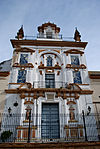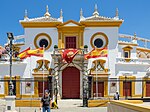Torre del Oro

The Torre del Oro (Arabic: بُرْج الذَّهَب, romanized: burj aḏẖ-ḏẖahab, lit. 'Tower of Gold') is a dodecagonal military watchtower in Seville, southern Spain. It was erected by the Almohad Caliphate in order to control access to Seville via the Guadalquivir river. Constructed in the first third of the 13th century, the tower served as a prison during the Middle Ages. Its name comes from the golden shine it projected on the river, due to its building materials (a mixture of mortar, lime and pressed hay). The tower is divided into three levels, the first level, dodecagonal, was built in 1220 by order of the Almohad governor of Seville, Abù l-Ulà; As for the second level, of only 8 meters, also dodecagonal, was built by Peter of Castile in the fourteenth century, a hypothesis that has been confirmed by archaeological studies; The third and uppermost being circular in shape was added after the previous third level, Almohad, was damaged by the 1755 Lisbon earthquake. Rebuilding of the third level was made by Brusselian military engineer Sebastian Van der Borcht in 1760. The Torre de la Plata, an octagonal tower, is located nearby, and is believed to have been constructed during the same era.
Excerpt from the Wikipedia article Torre del Oro (License: CC BY-SA 3.0, Authors, Images).Torre del Oro
Paseo Alcalde Marqués del Contadero, Seville Casco Antiguo
Geographical coordinates (GPS) Address Nearby Places Show on map
Geographical coordinates (GPS)
| Latitude | Longitude |
|---|---|
| N 37.382441666667 ° | E -5.9964666666667 ° |
Address
Torre del Oro
Paseo Alcalde Marqués del Contadero
41001 Seville, Casco Antiguo
Andalusia, Spain
Open on Google Maps











